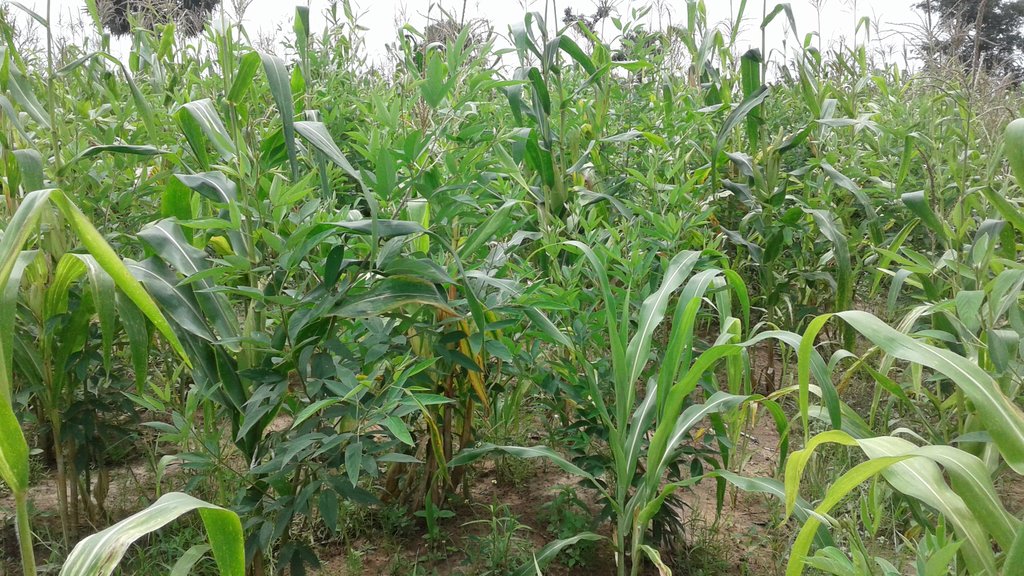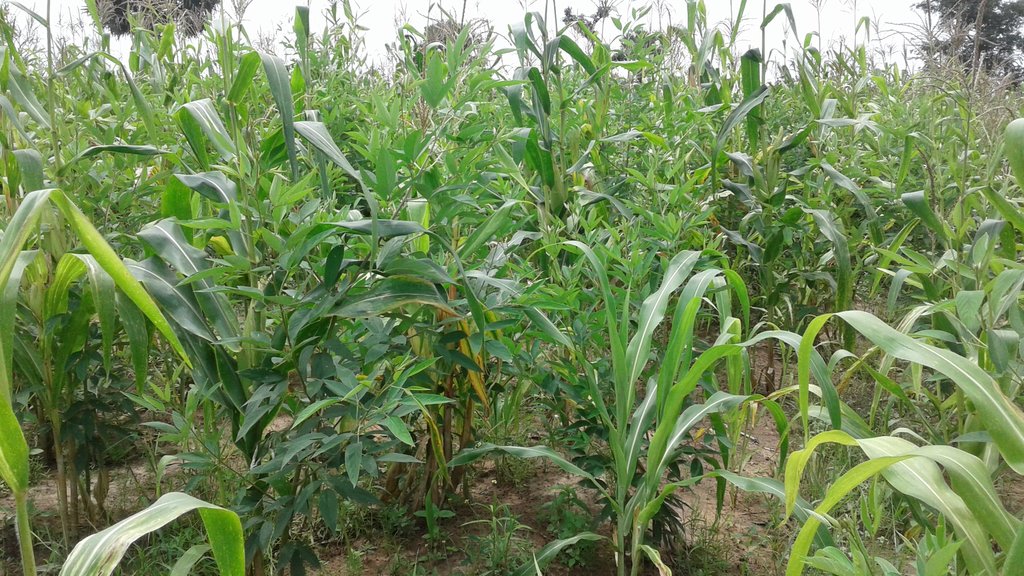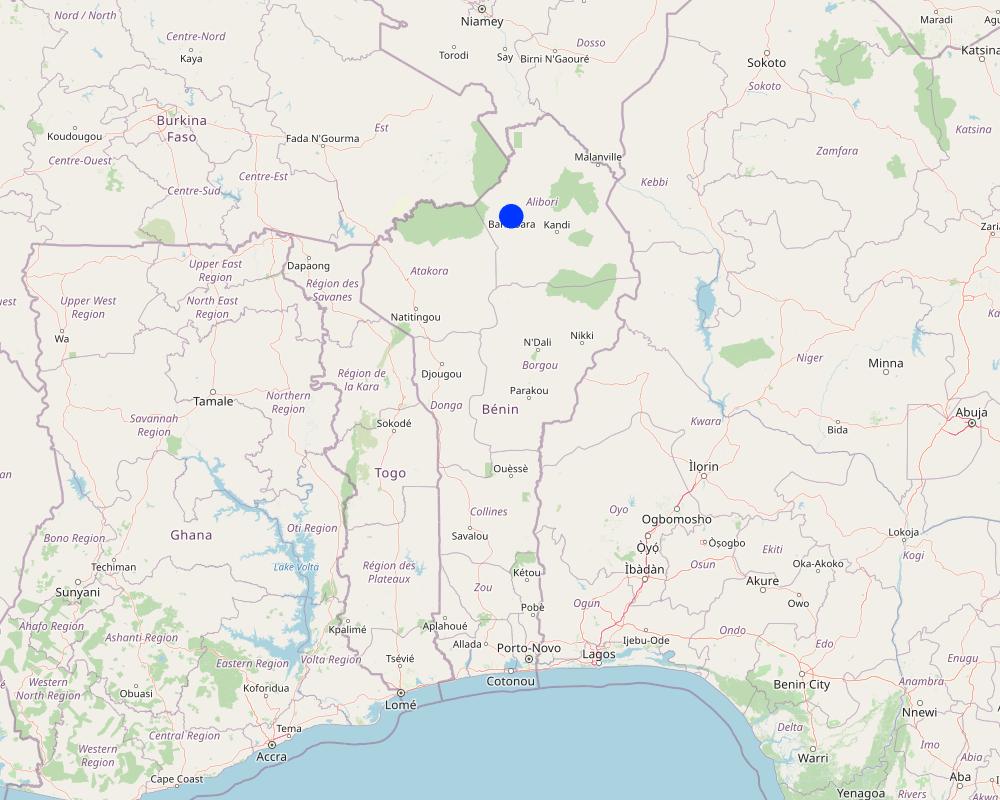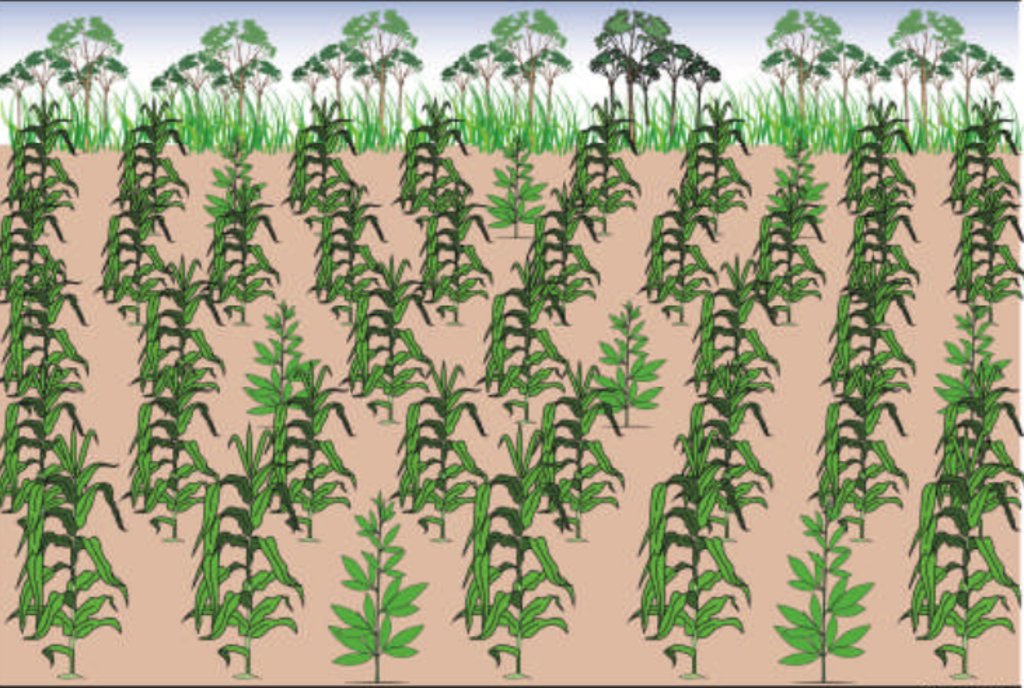Intercropping Pigeon Pea with Maize [Benin]
- Creation:
- Update:
- Compiler: Gatien AGBOKOUN CHRISTOPHE
- Editors: Siagbé Golli, Abdoul Karim MIEN, DOSSOU-YOVO bernardin, Tabitha Nekesa, Ahmadou Gaye
- Reviewers: Sally Bunning, William Critchley
Otri
technologies_6518 - Benin
View sections
Expand all Collapse all1. General information
1.2 Contact details of resource persons and institutions involved in the assessment and documentation of the Technology
Key resource person(s)
SLM specialist:
DOSSOUMON Roland
INUDE ONG
Benin
SLM specialist:
ALIOU Moumouni
INUDE ONG
Benin
Name of project which facilitated the documentation/ evaluation of the Technology (if relevant)
Soil protection and rehabilitation for food security (ProSo(i)l)Name of the institution(s) which facilitated the documentation/ evaluation of the Technology (if relevant)
Deutsche Gesellschaft für Internationale Zusammenarbeit (GIZ)1.3 Conditions regarding the use of data documented through WOCAT
The compiler and key resource person(s) accept the conditions regarding the use of data documented through WOCAT:
Yes
1.4 Declaration on sustainability of the described Technology
Is the Technology described here problematic with regard to land degradation, so that it cannot be declared a sustainable land management technology?
No
2. Description of the SLM Technology
2.1 Short description of the Technology
Definition of the Technology:
Pigeon pea, a leguminous shrub, enhances the physical and chemical characteristics of the soil. Through symbiotic nitrogen fixation, it can fix approximately 70 kg of nitrogen per hectare per season. When intercropped with maize, pigeon pea has the potential to double both maize yields and pigeon pea grain production.
2.2 Detailed description of the Technology
Description:
Pigeon pea, a leguminous shrub, is renowned for its capacity to enhance the physical and chemical characteristics of the soil. Through symbiotic nitrogen fixation, it can fix approximately 70 kg of nitrogen per hectare per season, extending until pod formation. When intercropped with maize, pigeon pea has the potential to double both maize yields and pigeon pea grain production, the latter being a valuable protein source. This technology boosts producers' income and contributes to food security. This combination utilized widely, excluding hydromorphic soils.
To implement this method, producers sow 20 kg/ha of maize seed and 20 kg/ha of pigeon pea, with 2 seeds per hole. Maize is sown using band sowing techniques, with a row spacing of 0.80 m and 1.60 m between plants at a depth of 3 to 5 cm. A row of maize is planted between two rows of pigeon peas, resulting in a density of 15,625 to 25,000 pigeon pea plants per hectare.
The combination of maize and pigeon pea is considered a climate change adaptation measure, as it allows for direct nitrogen input and helps improve soil productivity and fertility, thereby helping to guarantee food security and protect the soil in the long term.
Implementation and maintenance involve a succession of operations: soil preparation, seed purchase, ploughing, sowing of maize 2 to 4 weeks before pigeon pea sowing, followed by weed management as needed. Harvesting begins with maize, which matures earlier than pigeon peas. Threshing operations are then carried out. After the harvest, pigeon pea plants are pruned, and firewalls are installed to support the growth of new flowering stems.
Combining pigeon pea with maize also helps control maize pests, especially maize leaf pests. The foliage of pigeon pea provides ample biomass, which aids in soil fertilization, reduces soil evapotranspiration, and enhances microbial activity.
For producers, this technology is simple and easy to implement, often regarded as a valuable "treasure." There is a noticeable contrast for producers between fields where maize is combined with pigeon pea and those without. Control plots without pigeon pea typically yield 0.5 to 1 ton/ha of maize, while plots with pigeon pea have shown yields of up to 3 tons/ha of maize.
2.3 Photos of the Technology
2.5 Country/ region/ locations where the Technology has been applied and which are covered by this assessment
Country:
Benin
Region/ State/ Province:
Alibori
Further specification of location:
Banikoara
Specify the spread of the Technology:
- evenly spread over an area
If the Technology is evenly spread over an area, specify area covered (in km2):
1.0
Is/are the technology site(s) located in a permanently protected area?
No
Map
×2.6 Date of implementation
Indicate year of implementation:
2016
2.7 Introduction of the Technology
Specify how the Technology was introduced:
- through projects/ external interventions
Comments (type of project, etc.):
This technology was introduced by GIZ Benin's ProSOL project.
3. Classification of the SLM Technology
3.1 Main purpose(s) of the Technology
- improve production
- reduce, prevent, restore land degradation
- conserve ecosystem
- preserve/ improve biodiversity
- create beneficial economic impact
3.2 Current land use type(s) where the Technology is applied
Land use mixed within the same land unit:
No

Cropland
- Annual cropping
- Perennial (non-woody) cropping
Annual cropping - Specify crops:
- cereals - maize
- legumes and pulses - peas
Number of growing seasons per year:
- 1
Is intercropping practiced?
No
Is crop rotation practiced?
No
3.3 Has land use changed due to the implementation of the Technology?
Has land use changed due to the implementation of the Technology?
- Yes (Please fill out the questions below with regard to the land use before implementation of the Technology)
Land use mixed within the same land unit:
No

Cropland
- Annual cropping
- Perennial (non-woody) cropping
Annual cropping - Specify crops:
- cereals - maize
- Pigeon pea
Is intercropping practiced?
Yes
If yes, specify which crops are intercropped:
Pigeon pea is intercropped with maize.
Is crop rotation practiced?
No
3.4 Water supply
Water supply for the land on which the Technology is applied:
- rainfed
3.5 SLM group to which the Technology belongs
- improved ground/ vegetation cover
- integrated soil fertility management
3.6 SLM measures comprising the Technology

agronomic measures
- A1: Vegetation/ soil cover
- A2: Organic matter/ soil fertility
- A3: Soil surface treatment
- A6: Residue management
A3: Differentiate tillage systems:
A 3.1: No tillage
A6: Specify residue management:
A 6.4: retained

management measures
- M6: Waste management (recycling, re-use or reduce)
3.7 Main types of land degradation addressed by the Technology

chemical soil deterioration
- Cn: fertility decline and reduced organic matter content (not caused by erosion)

biological degradation
- Bh: loss of habitats
- Bq: quantity/ biomass decline
3.8 Prevention, reduction, or restoration of land degradation
Specify the goal of the Technology with regard to land degradation:
- reduce land degradation
- restore/ rehabilitate severely degraded land
4. Technical specifications, implementation activities, inputs, and costs
4.1 Technical drawing of the Technology
Technical specifications (related to technical drawing):
Maize seeding:
Maize is sown with a spacing of 40 cm between plants within the rows and 80 cm between rows. The seeds are sown at a depth of 3 to 5 cm, with 2 maize seeds per plot. A quantity of 20 kg of high-quality seeds is recommended for one hectare.
Pigeon pea seeding: Pigeon pea (Cajanus cajan) is sown with 2 seeds per plot, commencing two weeks after the maize is sown. The sowing spacing is set at 80 cm between rows of maize and 160 cm between rows (consisting of 2 rows of pigeon pea separated by 1 row of maize), at a depth of 3 to 5 cm. For 1 hectare, it is advisable to use 20 kg of high-quality pigeon pea seeds.
Author:
Marcellin Allagbe and Adolphe Adjanohoun
Date:
03/11/2019
4.2 General information regarding the calculation of inputs and costs
Specify how costs and inputs were calculated:
- per Technology area
Indicate size and area unit:
1ha
other/ national currency (specify):
CFA F
If relevant, indicate exchange rate from USD to local currency (e.g. 1 USD = 79.9 Brazilian Real): 1 USD =:
615.0
Indicate average wage cost of hired labour per day:
2500
4.3 Establishment activities
| Activity | Timing (season) | |
|---|---|---|
| 1. | Clearing | March-April |
| 2. | Plowing | May to June |
| 3. | Maize seeding | June to July |
| 4. | Pigeon pea seeding | June to July |
| 5. | Weeding | June to July |
| 6. | Maize harvesting | December |
| 7. | Pigeon pea harvesting | January to February |
4.4 Costs and inputs needed for establishment
| Specify input | Unit | Quantity | Costs per Unit | Total costs per input | % of costs borne by land users | |
|---|---|---|---|---|---|---|
| Labour | Clearing | ha | 1.0 | 15000.0 | 15000.0 | 100.0 |
| Labour | Ploughing | ha | 1.0 | 30000.0 | 30000.0 | 100.0 |
| Labour | Maize seeding | ha | 1.0 | 10000.0 | 10000.0 | 100.0 |
| Labour | Pigeon pea seeding | ha | 1.0 | 10000.0 | 10000.0 | 100.0 |
| Equipment | Weeding | ha | 1.0 | 12000.0 | 12000.0 | 100.0 |
| Equipment | Maize harvesting | ha | 1.0 | 15000.0 | 15000.0 | 100.0 |
| Equipment | Pigeon pea harvesting | ha | 1.0 | 10000.0 | 10000.0 | 100.0 |
| Plant material | Maize seeds | Kg | 20.0 | 300.0 | 6000.0 | 100.0 |
| Plant material | Pigeon pea seeds | kg | 20.0 | 500.0 | 10000.0 | |
| Total costs for establishment of the Technology | 118000.0 | |||||
| Total costs for establishment of the Technology in USD | 191.87 | |||||
4.5 Maintenance/ recurrent activities
| Activity | Timing/ frequency | |
|---|---|---|
| 1. | Coppicing | January to February |
| 2. | Firebreaking | November to December |
4.6 Costs and inputs needed for maintenance/ recurrent activities (per year)
| Specify input | Unit | Quantity | Costs per Unit | Total costs per input | % of costs borne by land users | |
|---|---|---|---|---|---|---|
| Labour | Coppicing | ha | 1.0 | 10000.0 | 10000.0 | 100.0 |
| Labour | Firebreaking | ha | 1.0 | 5000.0 | 5000.0 | 100.0 |
| Total costs for maintenance of the Technology | 15000.0 | |||||
| Total costs for maintenance of the Technology in USD | 24.39 | |||||
4.7 Most important factors affecting the costs
Describe the most determinate factors affecting the costs:
Labour scarcity
5. Natural and human environment
5.1 Climate
Annual rainfall
- < 250 mm
- 251-500 mm
- 501-750 mm
- 751-1,000 mm
- 1,001-1,500 mm
- 1,501-2,000 mm
- 2,001-3,000 mm
- 3,001-4,000 mm
- > 4,000 mm
Specify average annual rainfall (if known), in mm:
853.00
Agro-climatic zone
- semi-arid
5.2 Topography
Slopes on average:
- flat (0-2%)
- gentle (3-5%)
- moderate (6-10%)
- rolling (11-15%)
- hilly (16-30%)
- steep (31-60%)
- very steep (>60%)
Landforms:
- plateau/plains
- ridges
- mountain slopes
- hill slopes
- footslopes
- valley floors
Altitudinal zone:
- 0-100 m a.s.l.
- 101-500 m a.s.l.
- 501-1,000 m a.s.l.
- 1,001-1,500 m a.s.l.
- 1,501-2,000 m a.s.l.
- 2,001-2,500 m a.s.l.
- 2,501-3,000 m a.s.l.
- 3,001-4,000 m a.s.l.
- > 4,000 m a.s.l.
Indicate if the Technology is specifically applied in:
- not relevant
5.3 Soils
Soil depth on average:
- very shallow (0-20 cm)
- shallow (21-50 cm)
- moderately deep (51-80 cm)
- deep (81-120 cm)
- very deep (> 120 cm)
Soil texture (topsoil):
- medium (loamy, silty)
- fine/ heavy (clay)
Soil texture (> 20 cm below surface):
- medium (loamy, silty)
- fine/ heavy (clay)
Topsoil organic matter:
- low (<1%)
5.4 Water availability and quality
Ground water table:
5-50 m
Availability of surface water:
medium
Water quality (untreated):
poor drinking water (treatment required)
Water quality refers to:
ground water
Is water salinity a problem?
No
Is flooding of the area occurring?
Yes
Regularity:
episodically
5.5 Biodiversity
Species diversity:
- low
Habitat diversity:
- low
5.6 Characteristics of land users applying the Technology
Sedentary or nomadic:
- Sedentary
Market orientation of production system:
- mixed (subsistence/ commercial)
Off-farm income:
- less than 10% of all income
Relative level of wealth:
- poor
- average
Individuals or groups:
- groups/ community
Level of mechanization:
- animal traction
- mechanized/ motorized
Gender:
- women
- men
Age of land users:
- youth
- middle-aged
5.7 Average area of land used by land users applying the Technology
- < 0.5 ha
- 0.5-1 ha
- 1-2 ha
- 2-5 ha
- 5-15 ha
- 15-50 ha
- 50-100 ha
- 100-500 ha
- 500-1,000 ha
- 1,000-10,000 ha
- > 10,000 ha
Is this considered small-, medium- or large-scale (referring to local context)?
- small-scale
- medium-scale
5.8 Land ownership, land use rights, and water use rights
Land ownership:
- communal/ village
Land use rights:
- communal (organized)
Water use rights:
- communal (organized)
Are land use rights based on a traditional legal system?
Yes
Specify:
The patriarch of the clan divides the land among the children. Each child knows which area is dedicated to him or her.
5.9 Access to services and infrastructure
health:
- poor
- moderate
- good
education:
- poor
- moderate
- good
technical assistance:
- poor
- moderate
- good
employment (e.g. off-farm):
- poor
- moderate
- good
markets:
- poor
- moderate
- good
energy:
- poor
- moderate
- good
roads and transport:
- poor
- moderate
- good
drinking water and sanitation:
- poor
- moderate
- good
financial services:
- poor
- moderate
- good
6. Impacts and concluding statements
6.1 On-site impacts the Technology has shown
Socio-economic impacts
Production
crop production
Quantity before SLM:
1.5 t per hectare
Quantity after SLM:
2.5 t per hectare
Comments/ specify:
Combining corn with pigeon pea doubles maize yields
crop quality
Comments/ specify:
Once the crops have been combined over two seasons, chemical fertilizers are no longer required. The combination makes it easier to obtain organic products.
wood production
Comments/ specify:
After coppicing, the stems are used as firewood by women.
product diversity
Comments/ specify:
Pigeon pea seeds are edible.
land management
Income and costs
expenses on agricultural inputs
Comments/ specify:
Pigeon pea leaves yield sufficient biomass. This biomass facilitates soil fertilization.
farm income
Comments/ specify:
Improved yields translate into higher agricultural incomes.
economic disparities
workload
Socio-cultural impacts
food security/ self-sufficiency
Comments/ specify:
Improving maize yields and sourcing pigeon pea seeds help improve food security for producers
recreational opportunities
Comments/ specify:
By improving their income, producers can afford to spend more time on leisure activities.
SLM/ land degradation knowledge
Ecological impacts
Water cycle/ runoff
evaporation
Soil
soil organic matter/ below ground C
Climate and disaster risk reduction
micro-climate
6.2 Off-site impacts the Technology has shown
buffering/ filtering capacity
6.3 Exposure and sensitivity of the Technology to gradual climate change and climate-related extremes/ disasters (as perceived by land users)
Gradual climate change
Gradual climate change
| Season | increase or decrease | How does the Technology cope with it? | |
|---|---|---|---|
| annual temperature | increase | well | |
| seasonal temperature | dry season | decrease | moderately |
| annual rainfall | decrease | moderately | |
| seasonal rainfall | dry season | increase | well |
6.4 Cost-benefit analysis
How do the benefits compare with the establishment costs (from land users’ perspective)?
Short-term returns:
very positive
Long-term returns:
positive
How do the benefits compare with the maintenance/ recurrent costs (from land users' perspective)?
Short-term returns:
very positive
Long-term returns:
positive
6.5 Adoption of the Technology
- > 50%
Of all those who have adopted the Technology, how many did so spontaneously, i.e. without receiving any material incentives/ payments?
- 11-50%
6.6 Adaptation
Has the Technology been modified recently to adapt to changing conditions?
No
6.7 Strengths/ advantages/ opportunities of the Technology
| Strengths/ advantages/ opportunities in the land user’s view |
|---|
| Increased crop yields |
| Regeneration of soil fertility |
| Edibility of the seeds |
| Strengths/ advantages/ opportunities in the compiler’s or other key resource person’s view |
|---|
| Enhanced soil fertility |
| High nitrogen fixation capacity |
| Increased crop yields |
| Weed control capability |
6.8 Weaknesses/ disadvantages/ risks of the Technology and ways of overcoming them
| Weaknesses/ disadvantages/ risks in the land user’s view | How can they be overcome? |
|---|---|
| Maintenance difficulties, sudden bursting of pods | Carry out maintenance when seedlings are not too developed; harvest as pods turn brown. |
| Weaknesses/ disadvantages/ risks in the compiler’s or other key resource person’s view | How can they be overcome? |
|---|---|
| The market for pigeon pea grain is virtually non-existent. | Create warehouses for the sale of pigeon pea seeds; display pigeon pea seeds at agricultural fairs to promote their environmental, health and food safety benefits. |
7. References and links
7.1 Methods/ sources of information
- field visits, field surveys
1
- interviews with land users
1
- interviews with SLM specialists/ experts
1
- compilation from reports and other existing documentation
4
When were the data compiled (in the field)?
21/01/2023
7.2 References to available publications
Title, author, year, ISBN:
Deutsche Gesellschaft für Internationale Zusammenarbeit (GIZ) GmbH, 2018, Compendium de fiches techniques du formateur
Title, author, year, ISBN:
INRAB, 2015, Fiche Technique pour l'association du maïs et du pois d'angole pour l'amélioration de la fertilité et de l'humidité du sol au Sud du Bénin
Available from where? Costs?
https://www.researchgate.net/publication/331862221_FICHE_TECHNIQUE_08
Title, author, year, ISBN:
AMADJI Firmin. 2004, Pour une amélioration durable de la fertilité du sol et des rendements au centre et au sud Bénin. Bulletin de la Recherche Agronomique du Bénin (BRAB), Annales des Sciences Agronomiques du Bénin. 2 (2): 123 -139
Title, author, year, ISBN:
BADOU A., AKONDE P. T., ADJANOHOUN A., ADJE I. T., AÏHOU K.et IGUE A. M. 2013, Effets de différents modes de gestion des résidus de soja sur le rendement du maïs dans les conditions agroécologiques du CentreBénin. Bulletin de la Recherche agronomique du Bénin (BRAB), Numéro spécial Fertilité du maïs – Janvier : 34-38. BRAB
Available from where? Costs?
http://www.slire.net
Links and modules
Expand all Collapse allLinks
No links
Modules
No modules






